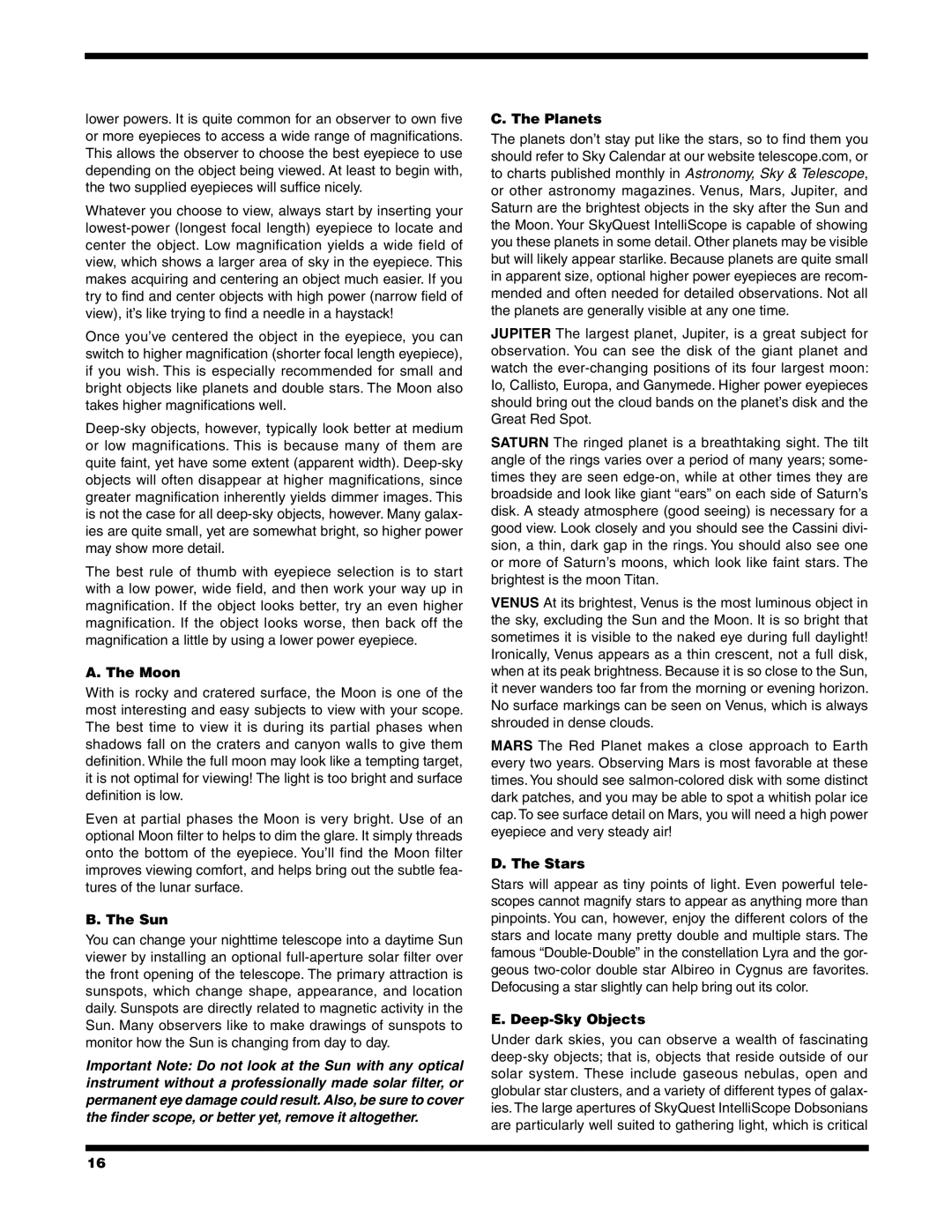
lower powers. It is quite common for an observer to own five or more eyepieces to access a wide range of magnifications. This allows the observer to choose the best eyepiece to use depending on the object being viewed. At least to begin with, the two supplied eyepieces will suffice nicely.
Whatever you choose to view, always start by inserting your
Once you’ve centered the object in the eyepiece, you can switch to higher magnification (shorter focal length eyepiece), if you wish. This is especially recommended for small and bright objects like planets and double stars. The Moon also takes higher magnifications well.
The best rule of thumb with eyepiece selection is to start with a low power, wide field, and then work your way up in magnification. If the object looks better, try an even higher magnification. If the object looks worse, then back off the magnification a little by using a lower power eyepiece.
A. The Moon
With is rocky and cratered surface, the Moon is one of the most interesting and easy subjects to view with your scope. The best time to view it is during its partial phases when shadows fall on the craters and canyon walls to give them definition. While the full moon may look like a tempting target, it is not optimal for viewing! The light is too bright and surface definition is low.
Even at partial phases the Moon is very bright. Use of an optional Moon filter to helps to dim the glare. It simply threads onto the bottom of the eyepiece. You’ll find the Moon filter improves viewing comfort, and helps bring out the subtle fea- tures of the lunar surface.
B. The Sun
You can change your nighttime telescope into a daytime Sun viewer by installing an optional
Important Note: Do not look at the Sun with any optical instrument without a professionally made solar filter, or permanent eye damage could result. Also, be sure to cover the finder scope, or better yet, remove it altogether.
C. The Planets
The planets don’t stay put like the stars, so to find them you should refer to Sky Calendar at our website telescope.com, or to charts published monthly in Astronomy, Sky & Telescope, or other astronomy magazines. Venus, Mars, Jupiter, and Saturn are the brightest objects in the sky after the Sun and the Moon. Your SkyQuest IntelliScope is capable of showing you these planets in some detail. Other planets may be visible but will likely appear starlike. Because planets are quite small in apparent size, optional higher power eyepieces are recom- mended and often needed for detailed observations. Not all the planets are generally visible at any one time.
JUPITER The largest planet, Jupiter, is a great subject for observation. You can see the disk of the giant planet and watch the
SATURN The ringed planet is a breathtaking sight. The tilt angle of the rings varies over a period of many years; some- times they are seen
VENUS At its brightest, Venus is the most luminous object in the sky, excluding the Sun and the Moon. It is so bright that sometimes it is visible to the naked eye during full daylight! Ironically, Venus appears as a thin crescent, not a full disk, when at its peak brightness. Because it is so close to the Sun, it never wanders too far from the morning or evening horizon. No surface markings can be seen on Venus, which is always shrouded in dense clouds.
MARS The Red Planet makes a close approach to Earth every two years. Observing Mars is most favorable at these times. You should see
D. The Stars
Stars will appear as tiny points of light. Even powerful tele- scopes cannot magnify stars to appear as anything more than pinpoints. You can, however, enjoy the different colors of the stars and locate many pretty double and multiple stars. The famous
E. Deep-Sky Objects
Under dark skies, you can observe a wealth of fascinating
16
